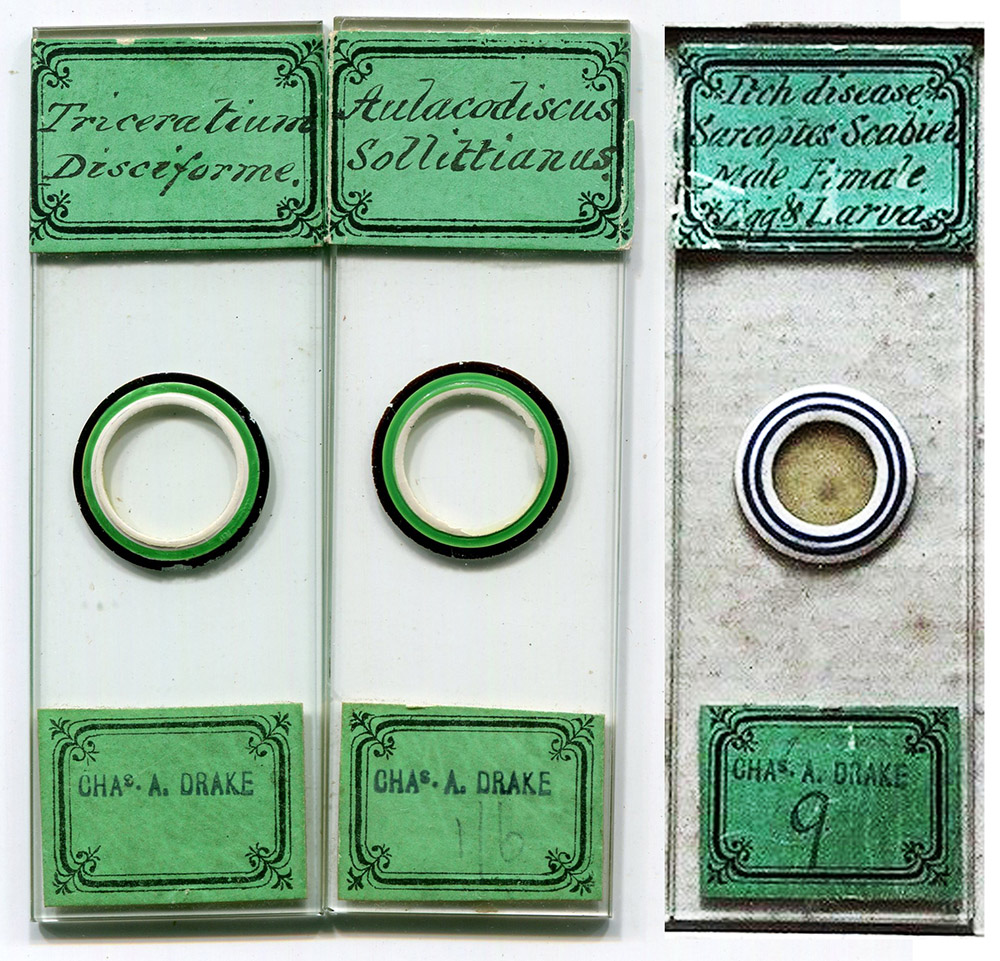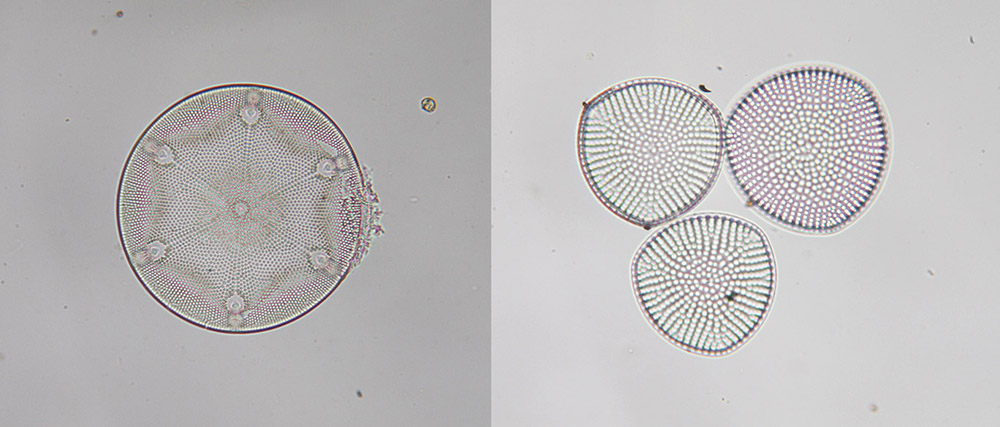Charles Alexander Drake, 1851 - 1911
by Brian Stevenson
last updated June, 2025
Charles Drake was a member of the Quekett Microscopical Club from 1883 until about 1898. His microscope slides probably date from that time (Figures 1 and 2). Several consist of selected and arranged diatoms, and all known examples have colorful ringing, which indicate that Drake had substantial skill as a slide-maker. Professionally, he was a brewer and distiller at the Three Mills Distillery in West Ham, Essex.

Figure 1.
Microscope slides by Charles Drake. All show skillful application of multi-colored ringing around the coverslips. The labels are an off-the-shelf variety, with “Chas. A. Drake” applied with a rubber stamp. Drake’s slides probably date from around the time that he was a member of the Quekett Microscopical Club, 1883 – ca. 1898. From the author’s collection or adapted for nonprofit, educational purposes from an internet auction site.

Figure 2.
Aulacodiscus sollittianus and Triceratium disciforme diatoms, selected and arranged by Charles Drake (see Figure 1). Imaged with a 10x objective lens and C-mounted digital SLR camera on a Leitz Ortholux II microscope.
Charles Alexander Drake was born on May 22, 1851 in the Ashted section of Birmingham, England. He appears to be the second of two children, and only son, of Joseph and Ann Drake. At the time of Charles’ birth, father Joseph was a Sergeant in the Fourth Dragoon Guards.
Joseph Drake retired from the military during the 1850s, then took a job as a clerk with the Three Mills Distillery, in West Ham, Essex. The 1861 national census noted that he was a “Chelsea Pensioner”. His new job evidently paid fairly well, as the Drake family employed a general domestic servant. By the time of the 1871 census, Joseph Drake was “managing clerk” of the distillery. Charles Drake, then 19 years old, was working as a brewer in the distillery.
On April 27, 1875, Charles married Emma Jane Dives. She was a daughter of the distillery’s miller, and grew up on the same street as Charles. The couple had a son, then four daughters. The son, Joseph, followed Charles in the distillery business.
Charles Drake was elected to membership in the Quekett Microscopical Club on May 25, 1883. Despite his evident skills as a mounter, Drake does not show up very often in QMC records. I found only that he exhibited a slide on “cyclosis in Nitella” during 1889. He disappeared from QMC member rolls between 1897 and 1899.
Drake joined the Society of Chemical Industry in 1885, the Society of Arts in 1894, and the Institute of Brewing in 1909.
A fatal accident struck The Three Mills Distillery on July 12, 1901, with reports listing Charles Drake as the “resident manager”. According to news reports, “On some land on the north-east side of the distillery there is a well into which drains the waste water of the surrounding ground, which is quite close to the backwater of the River Lea, running through the distillery. This well had not been inspected far a long time. and yesterday afternoon it was decided to ‘dip’ it to ascertain the depth of water … A ladder was let down, and a man named Pickett descended told put a rod to the bottom of the well. He handed the rod to Mr Elliott, the foremen, who said that the water registered 11 feet deep. Suddenly, Pickett fell to the bottom of the well, having been overcome, as it afterwards transpired, by foul air, Mr Godfrey Nicholson, not understanding the cause of the man's disappearance, at once went down the ladder to his assistance, and he, too, as soon as he got down a little way, was also overcome, and fell. Then Mr. Elliott, the foreman, went to the rescue of his master and the other man, and he in his turn was overcome and disappeared. A similar fate happened to a man named Underhill, who followed. A fifth man also descended the well a little way, but was got up quickly, and so escaped the fate of the others. Meanwhile, an alarm had been raised and other workmen flocked to the spot, and Mr. Drake, the resident manager, had some difficulty in preventing other men going down the well”. “The bodies, shortly after recovery, were removed to Mr Drake's house in the distillery, which was temporarily used as a mortuary”. At the inquest, the coroner “questioned Charles Drake, as to why, as was the normal case in these circumstances, a lit candle had not been used first in order to test the air prior to any of the men descending into the well. Drake observed that, with hindsight, such a course of action would have been sensible. But, he also pointed out that, at the time, there had been no reason to suspect the presence of gas and there had, most certainly, been no sign of it when the well was initially opened”. “Indeed, in considering the chain of events that resulted in the tragedy, the following hypothesis was put forward at the inquest. When the well had been sealed, several years before, rotting weeds had been left in its depths and, as they began to decompose, they had given off gas which had subsequently accumulated beneath the water. When Thomas Pickett disturbed the water with the measuring stick the gas had escaped, rendering him unconscious and his subsequent fall into the water caused more gas to leak out, and this, in turn, asphyxiated Nicholson, Elliott and Underhill”.
Charles Drake died at the age of 60, on September 18, 1911.
In 1920, “A destructive fire broke out on Sunday at the premises of Nicholson & Co., Ltd., distillers, Three Mill Lane, Bromley-by-Bow, E. The distillery comprised buildings of two and three floors, 240 ft. by 170 ft. used as grain stores, malt mills, and drying kilns. The fire had gained considerable hold, and before the brigade could get it under control half of the premises had been severely damaged. One of the walls of the building which overhangs the canal collapsed, bringing the roof with it, and a barge filled with grain was sunk by the weight of the débris. Between 5,000 and 6,000 quarters of grain was stored in the granary, and much of it was destroyed, but the fire was prevented from spreading to the whisky tanks. Some damage was done to adjoining properties”. “Distilling ceased after the mills sustained severe air-raid damage during the Second World War, but the site continued to be used for bottling and warehousing by Nicholson, and from the early 1970s until the early 1990s, by Charrington and Hedges & Butler”. The rebuilt Three Mills complex is now a film studio.

Figure 3.
Three Mills, as it would have appeared in Charles Drake’s time. Power was generated by water wheels that ran on the tides of River Thames. Adapted for nonprofit, educational purposes from https://3mills.com/about-us/history
Resources
Chemical Age (1920) Report of the fire at Three Mills Distillery, page 133
England census and other records, accessed through ancestry.com
Journal of the Quekett Microscopical Club (1883) Members, “May 25, 1883. Drake, C.A., The Distillery, Three Mill Lane, Bromley-by-Bow”
Journal of the Quekett Microscopical Club (1889) “Cyclosis in Nitella … Mr. C.A. Drake”, page 42
Journal of the Quekett Microscopical Club (1897) Members, “May 25, 1883. Drake, C.A., The Distillery, Three Mill lane, Bromley-by-Bow”
Journal of the Quekett Microscopical Club (1899) C.A. Drake not listed as a Member
Journal of the Society of Arts (1894) “The following candidates were proposed, balloted for, and duly elected members of the Society, Drake, Charles Alexander, Three Mills Distillery, Bromley, Bow, E.”, Vol. 42, pages 689-690
The Journal of the Society of Chemical Industry (1885) “List of Members elected Frebruary 23rd, 1885, Chas. A. Drake, Three Mills Distillery, Bromley by Bow, E., Brewer”, Vol. 4, page 69
Probate of the Will of Charles A. Drake (1911) “Drake Charles Alexander of Three Mills Distillery Bromley-by-Bow Middlesex died 18 September 1911 Probate London 28 October to Emma Jane Drake widow. Effects £1140 11s 1d”, accessed through ancestry.com
The Sunderland Daily Echo (1901) A poisonous old well, sad affair near London, four men suffocated, July 13 issue, accessed from https://www.london-walking-tours.co.uk/postmans-park/nicholson-elliott-and-underhill.htm
3 Mills Studio and Three Mills Island History (accessed June, 2025) https://3mills.com/about-us/history


